Response Analysis of Curved Tunnel under Near-Field Long-Period Ground Motion Considering Seismic Wave Propagation Effect
Abstract
1. Introduction
2. Dynamic Equation of a Tunnel under Seismic Wave Propagation Effect
3. Numerical Models
- (1)
- The pipe segments bolted in the actual project are assumed to be homogeneous rings;
- (2)
- The soil and tunnel structure materials are assumed to be homogeneous, isotropic.
4. Results and Discussion
4.1. Study on Tunnel Parameterization
4.1.1. Influence of Lining Thickness and Tunnel Depth
4.1.2. Influence of Turning Radius
4.2. The Effect of Seismic Wave Propagation on a Tunnel
5. Conclusions
Author Contributions
Funding
Institutional Review Board Statement
Informed Consent Statement
Data Availability Statement
Conflicts of Interest
References
- Pitilakis, K.; Alexoudi, M.; Argyroudis, S.; Monge, O.; Martin, C. Earthquake risk assessment of lifelines. Bull. Earthq. Eng. 2006, 4, 365–390. [Google Scholar] [CrossRef]
- Song, D.; Liu, X.; Huang, J.; Zhang, J. Energy-based analysis of seismic failure mechanism of a rock slope with discontinuities using Hilbert-Huang transform and marginal spectrum in the time-frequency domain. Landslides 2021, 18, 105–123. [Google Scholar] [CrossRef]
- Song, D.; Liu, X.; Huang, J.; Wang, E.; Zhang, J. Characteristics of wave propagation through rock mass slopes with weak structural planes and their impacts on the seismic response characteristics of slopes: A case study in the middle reaches of Jinsha River. Bull. Eng. Geol. Environ. 2020, 80, 1317–1334. [Google Scholar] [CrossRef]
- Dai, M.; Li, Y.; Dong, Y. Incorporation of envelope delays and amplifications into simulation of far-field long-period ground motions. Soil Dyn. Earthq. Eng. 2020, 136, 106192. [Google Scholar] [CrossRef]
- Patil, M.; Choudhury, D.; Ranjith, P.G.; Zhao, J. Behavior of shallow tunnel in soft soil under seismic conditions. Tunn. Undergr. Space Technol. 2018, 82, 30–38. [Google Scholar] [CrossRef]
- Ma, C.; Lu, D.; Du, X.; Qi, C. Effect of buried depth on seismic response of rectangular underground structures considering the influence of ground loss. Soil Dyn. Earthq. Eng. 2018, 106, 278–297. [Google Scholar] [CrossRef]
- Asakura, T.; Shiba, Y.; Matsuoka, S.; Oya, T.; Yashiro, K. Damage to mountain tunnels by earthquake and its mechanism. Doboku Gakkai Ronbunshu. 2000, 659, 27–38. (In Japanese) [Google Scholar] [CrossRef]
- Hashash, Y.M.A.; Hook, J.J.; Schmidt, B.; I-Chiang Yao, J. Seismic design and analysis of underground structures. Tunn. Undergr. Space Technol. 2001, 16, 247–293. [Google Scholar] [CrossRef]
- Wang, W.L.; Wang, T.T.; Su, J.J.; Lin, C.H.; Seng, C.R.; Huang, T.H. Assessment of damage in mountain tunnels due to the Taiwan Chi-Chi Earthquake. Tunn. Undergr. Space Technol. 2001, 16, 133–150. [Google Scholar] [CrossRef]
- Wang, Z.; Gao, B.; Jiang, Y.; Yuan, S. Investigation and assessment on mountain tunnels and geotechnical damage after the Wenchuan earthquake. Sci. China Ser. E Technol. Sci. 2009, 52, 546–558. [Google Scholar] [CrossRef]
- Cui, G.; Wang, M.; Lin, G. Statistical analysis of Earthquake damage types of typical highway tunnel lining structure in Wenchuan seismic disastrous area. Chin. J. Geol. Hazard Control. 2011, 22, 122–127. [Google Scholar] [CrossRef]
- Maleska, T.; Nowacka, J.; Beben, D. Application of EPS Geofoam to a Soil–Steel Bridge to Reduce Seismic Excitations. Geosciences 2019, 9, 448. [Google Scholar] [CrossRef]
- Maleska, T.; Beben, D.; Nowacka, J. Seismic vulnerability of a soil-steel composite tunnel—Norway Tolpinrud Railway Tunnel Case Study. Tunn. Undergr. Space Technol. 2021, 110, 103808. [Google Scholar] [CrossRef]
- Mahgoub, A.; Naggar, H.E. Seismic Design of Metal Arch Culverts: Design Codes Vs. Full Dynamic Analysis. J.Earthq. Eng. 2019, 25, 2231–2268. [Google Scholar] [CrossRef]
- Oskouei, A.G.; Oskouei, A.V. The Effect of P-Wave Propagation on the Seismic Behavior of Steel Pipelines. Period. Polytech.-Civ. 2017, 61, 889–903. [Google Scholar] [CrossRef][Green Version]
- Abate, G.; Massimino, M.R. Parametric analysis of the seismic response of coupled tunnel–soil–aboveground building systems by numerical modelling. Bull.Earthq. Eng. 2017, 15, 443–467. [Google Scholar] [CrossRef]
- Liao, W.; Loh, C.-H.; Wan, S. Earthquake responses of RC moment frames subjected to near-fault ground motions. Struct. Des. Tall Spec. Build. 2001, 10, 219–229. [Google Scholar] [CrossRef]
- Shahi, S.K.; Baker, J.W. An Empirically Calibrated Framework for Including the Effects of Near-Fault Directivity in Probabilistic Seismic Hazard Analysis. Bull. Seismol. Soc. Am. 2011, 101, 742–755. [Google Scholar] [CrossRef]
- Kalkan, E.; Kunnath, S.K. Effects of Fling Step and Forward Directivity on Seismic Response of Buildings. Earthq. Spectra 2006, 22, 367–390. [Google Scholar] [CrossRef]
- Bray, J.D.; Rodriguez-Marek, A. Characterization of forward-directivity ground motions in the near-fault region. Soil Dyn. Earthq. Eng. 2004, 24, 815–828. [Google Scholar] [CrossRef]
- Ariga, T.; Kanno, Y.; Takewaki, I. Resonant behaviour of base-isolated high-rise buildings under long-period ground motions. Struct. Des. Tall Spec. Build. 2006, 15, 325–338. [Google Scholar] [CrossRef]
- Mai, P.M.; Imperatori, W.; Olsen, K.B. Hybrid Broadband Ground-Motion Simulations: Combining Long-Period Deterministic Synthetics with High-Frequency Multiple S-to-S Backscattering. Bull. Seismol. Soc. Am. 2010, 100, 2124–2142. [Google Scholar] [CrossRef]
- Chang, Z.; Sun, X.; Zhai, C.; Zhao, J.X.; Xie, L. An improved energy-based approach for selecting pulse-like ground motions. Earthq. Eng. Struct. Dyn. 2016, 45, 2405–2411. [Google Scholar] [CrossRef]
- Fathi, M.A.; Makhdoumi, M. Parvizi. Effect of supplemental damping on seismic response of base isolated frames under near & far field accelerations, Ksce. J. Civ. Eng. 2015, 19, 1359–1365. [Google Scholar] [CrossRef]
- Yang, D.; Pan, J.; Li, G. Non-structure-specific intensity measure parameters and characteristic period of near-fault ground motions. Earthq. Eng. Struct. D 2009, 38, 1257–1280. [Google Scholar] [CrossRef]
- Anderson, J.; Bertero, V. Uncertainties in establishing design earthquakes. J. Struct. Eng. 1987, 113, 1709–1724. [Google Scholar] [CrossRef]
- Brun, M.; Reynouard, J.M.; Jezequel, L.; Ile, N. Damaging potential of low-magnitude near-field earthquakes on low-rise shear walls. Soil Dyn. Earthq. Eng. 2004, 24, 587–603. [Google Scholar] [CrossRef]
- Zhao, X.; Shuping, J.; Yi, Y. Study on Shaking Table Model Test Scheme of Tunnel Subjected to Near-Fault Pulse-Like Ground Motions. Mod. Appl. Sci. 2014, 8, 126–139. [Google Scholar] [CrossRef]
- Sun, B.; Zhang, S.; Deng, M.; Wang, C. Inelastic dynamic response and fragility analysis of arched hydraulic tunnels under as-recorded far-fault and near-fault ground motions. Soil Dyn. Earthq. Eng. 2020, 132, 106070. [Google Scholar] [CrossRef]
- Chen, Z.; Wei, J. Correlation between ground motion parameters and lining damage indices for mountain tunnels. Nat. Hazards 2013, 65, 1683–1702. [Google Scholar] [CrossRef]
- Cui, Z.; Sheng, Q.; Leng, X. Effects of a controlling geological discontinuity on the seismic stability of an underground cavern subjected to near-fault ground motions. Bull. Eng. Geol. Environ. 2018, 77, 265–282. [Google Scholar] [CrossRef]
- Chen, Z.; Liang, S.; Shen, H. Dynamic centrifuge tests on effects of isolation layer and cross-section dimensions on shield tunnels. Soil Dyn. Earthq. Eng. 2018, 109, 173–187. [Google Scholar] [CrossRef]
- Jza, B.; Yong, Y.; Zhen, B.D. Shaking table tests on shaft-tunnel junction under longitudinal excitations. Soil Dyn. Earthq. Eng. 2020, 132, 106055. [Google Scholar] [CrossRef]
- Chen, Z.Y.; Shen, H. Dynamic centrifuge tests on isolation mechanism of tunnels subjected to seismic shaking. Tunn. Undergr. Space Technol. 2014, 42, 67–77. [Google Scholar] [CrossRef]
- Zhang, J.; Yuan, Y.; Yu, H. Shaking table tests on discrepant responses of shaft-tunnel junction in soft soil under transverse excitations. Soil Dyn. Earthq. Eng. 2019, 120, 345–359. [Google Scholar] [CrossRef]
- Chen, Z.Y.; Liang, S.B.; He, C. Influence of Incoherence and Wave Passage Effects on Seismic Performances of Long Immersed Tunnel. Int. J. Comput. Methods 2017, 16, 1840012. [Google Scholar] [CrossRef]
- Yan, X.; Yuan, J.; Yu, H. Multi-point shaking table test design for long tunnels under non-uniform seismic loading. Tunn. Undergr. Space Technol. 2016, 59, 114–126. [Google Scholar] [CrossRef]
- Yu, H.; Yuan, Y.; Xu, G.; Su, Q.; Yan, X.; Li, C. Multi-point shaking table test for long tunnels subjected to non-uniform seismic loadings-part II: Application to the HZM immersed tunnel. Soil Dyn. Earthq. Eng. 2018, 108, 187–195. [Google Scholar] [CrossRef]
- Han, J.; El Naggar, M.H.; Zhao, M.; Zhong, Z.; Hou, B.; DU, X. Longitudinal response of buried pipeline under non-uniform seismic excitation from multi-point shaking table tests. Soil Dyn. Earthq. Eng. 2021, 140, 106440. [Google Scholar] [CrossRef]
- Kuznetsov, S.V. Seismic waves and seismic barriers. Acoust. Phys. 2011, 57, 420–426. [Google Scholar] [CrossRef]
- Sun, Q.; Diasm, D.; Sousa, L. Soft soil layer-tunnel interaction under seismic loading. Tunn. Undergr. Space Technol. 2020, 98, 103329. [Google Scholar] [CrossRef]
- Huang, Z.H.; Zhang, D.M. Scalar- and vector-valued vulnerability analysis of shallow circular tunnel in soft soil. Transp. Geotech. 2021, 27, 100505. [Google Scholar] [CrossRef]
- Mh, A.; Aa, B. Performance-based analysis of tunnels under seismic events with nonlinear features of soil mass and lining. Soil Dyn. Earthq. Eng. 2021, 134, 106158. [Google Scholar] [CrossRef]
- Zhang, Z.; Chen, F.; Li, N.; Swoboda, G.; Liu, N. Influence of fault on thesurrounding rock stability of a tunnel: Location and thickness. Tunn. Undergr. Space Technol. 2017, 61, 1–11. [Google Scholar] [CrossRef]
- Rayhani, M.H.T.; El Naggar, M.H. Numerical modeling of seismic response of rigid foundation on soft soil. Int. J. Geomech. 2008, 8, 336–346. [Google Scholar] [CrossRef]
- Bilotta, E.; De Sanctis, L.; Di Larora, R.; D’Onofrio, A.; Silvestri, F. Importance of seismic site response and soil-structure interaction in dynamic behaviour of a tall building. Geotechnique 2015, 65, 391–400. [Google Scholar] [CrossRef]
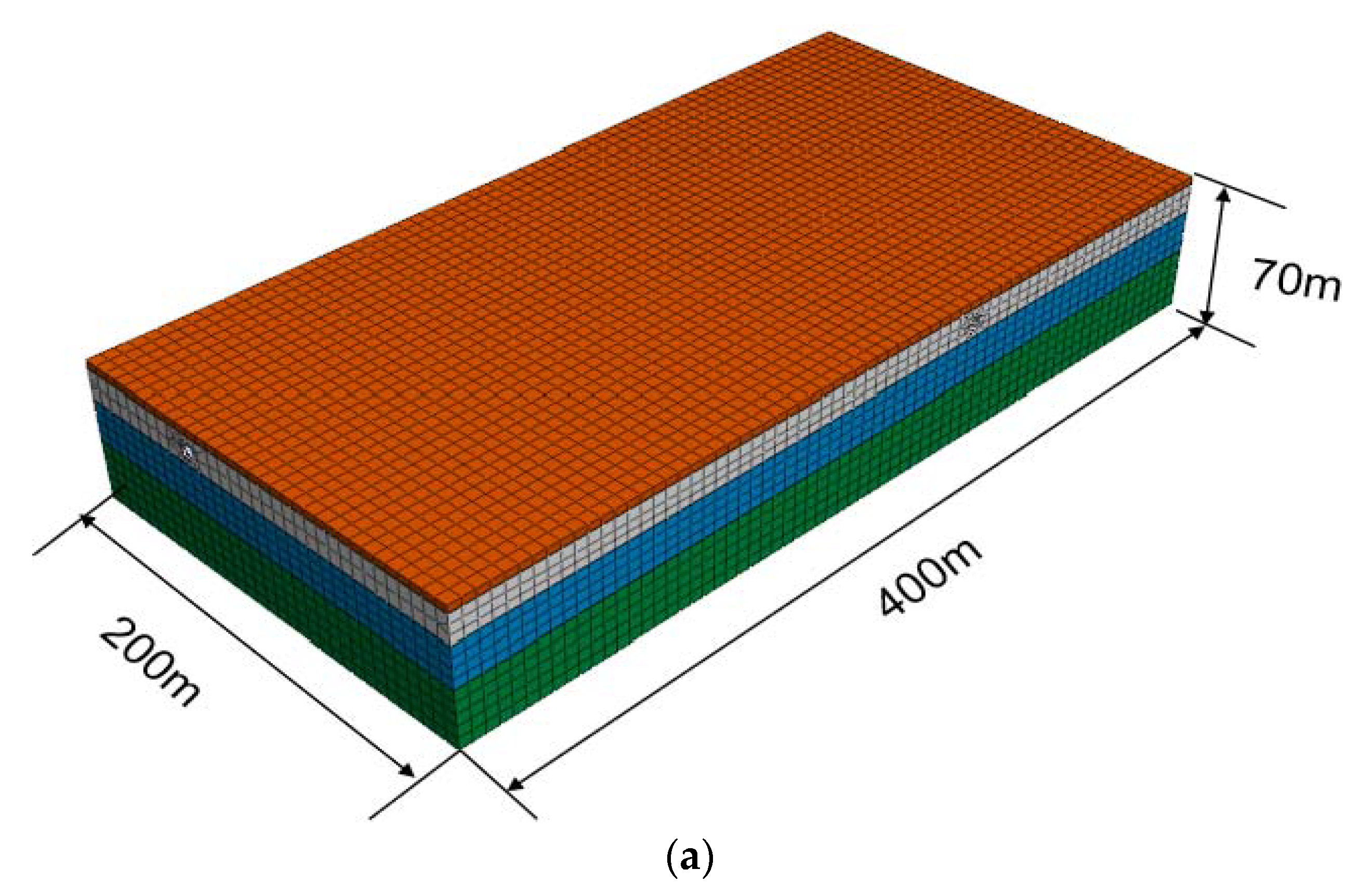
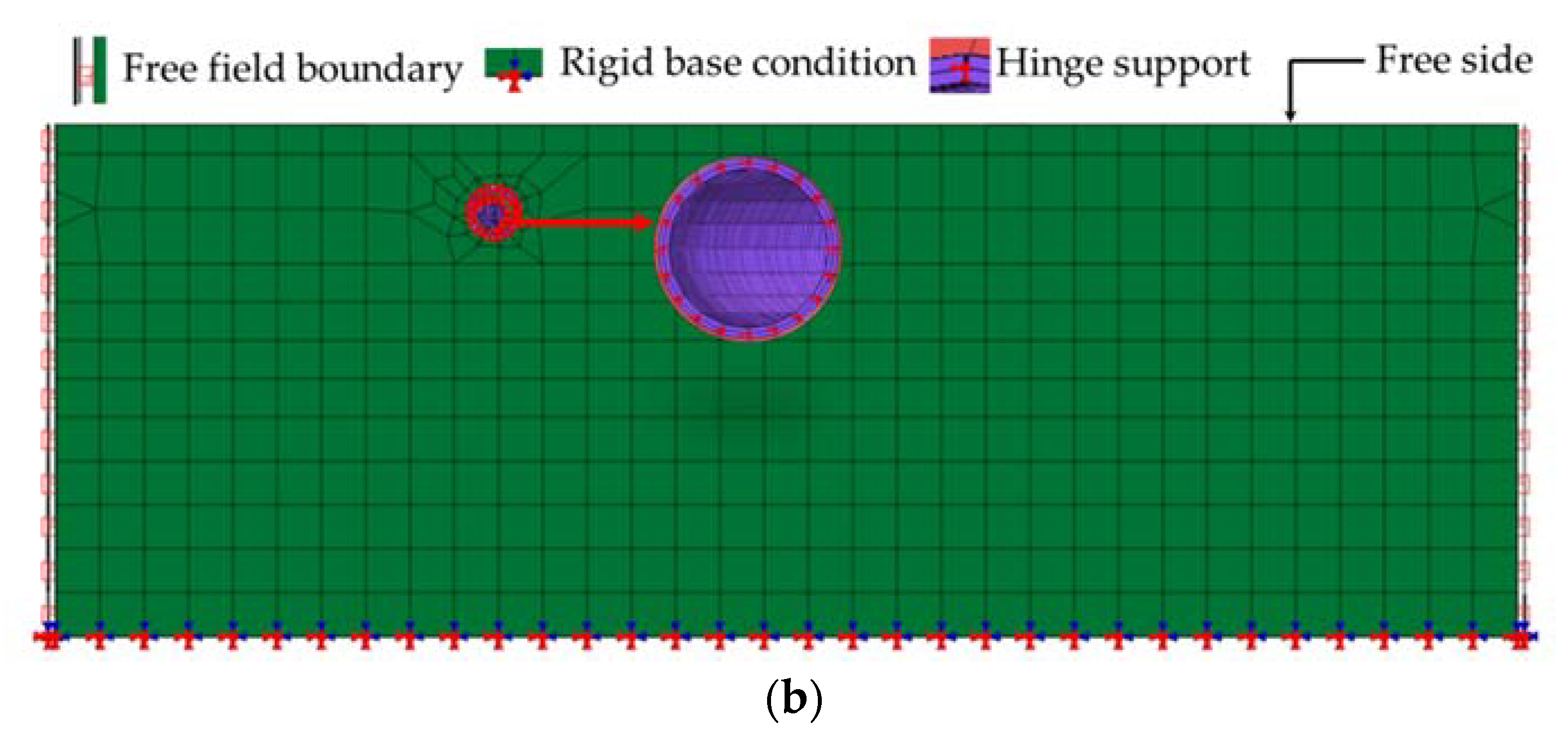
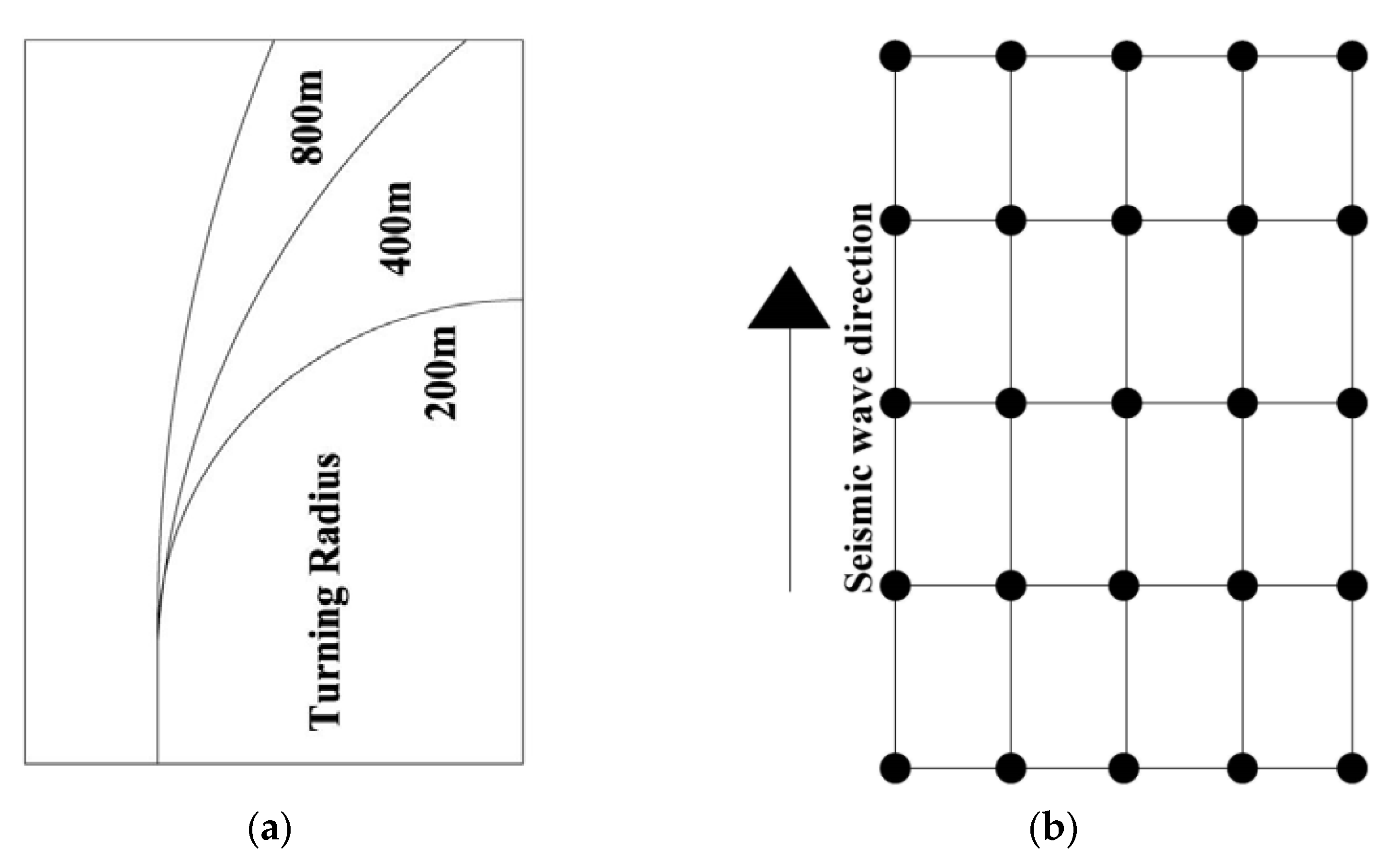
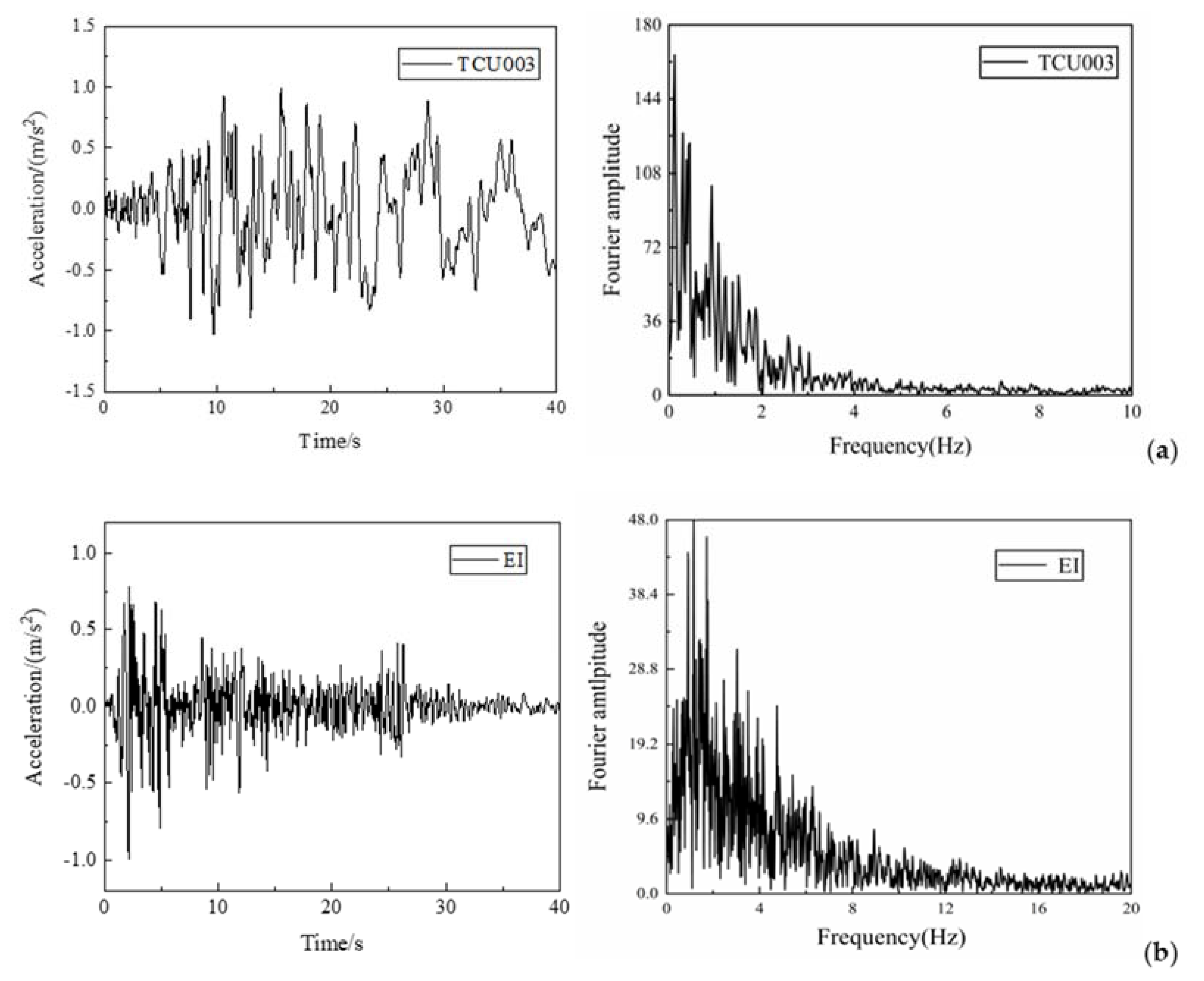
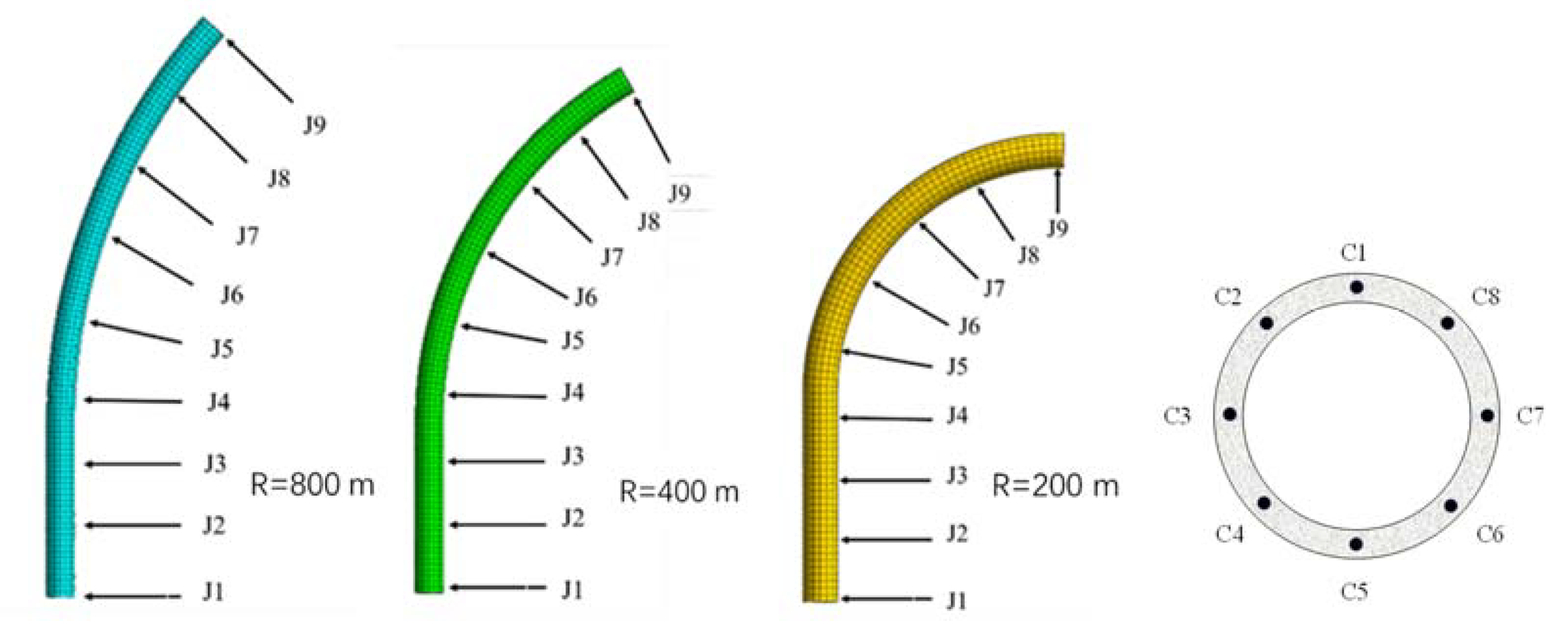

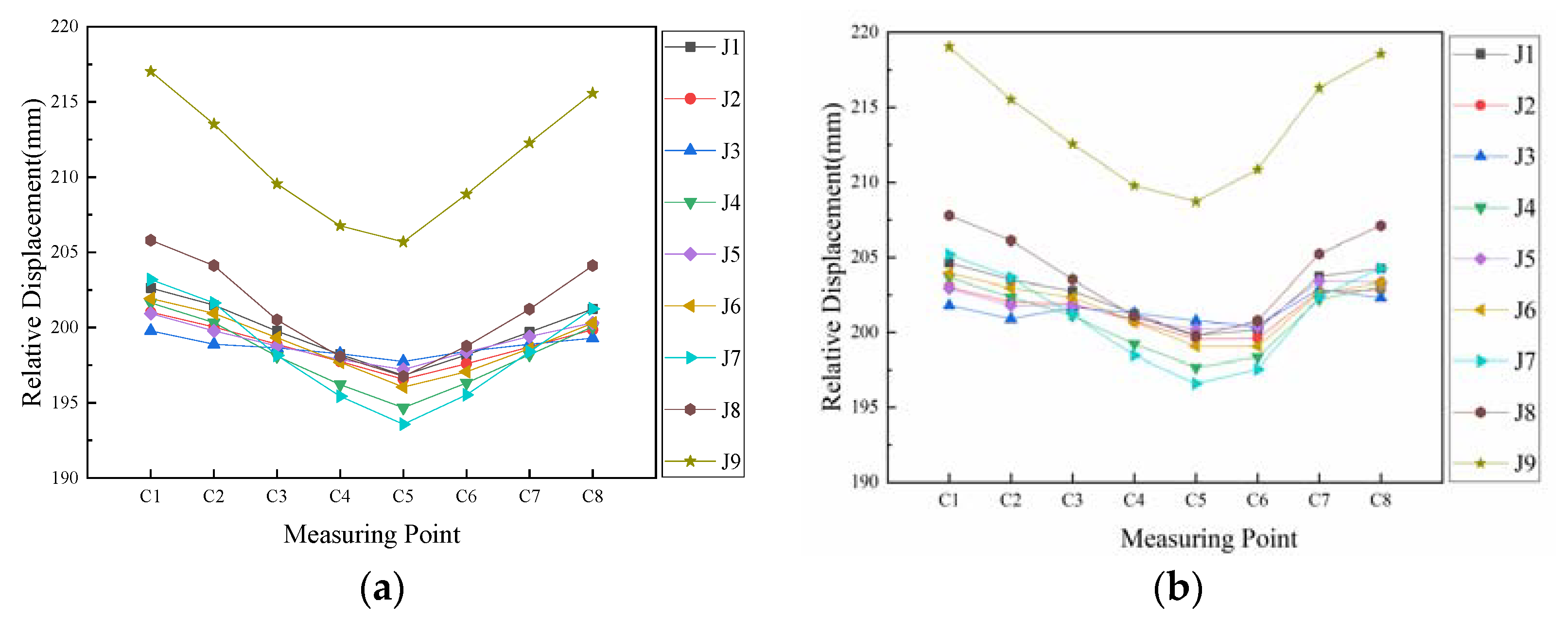
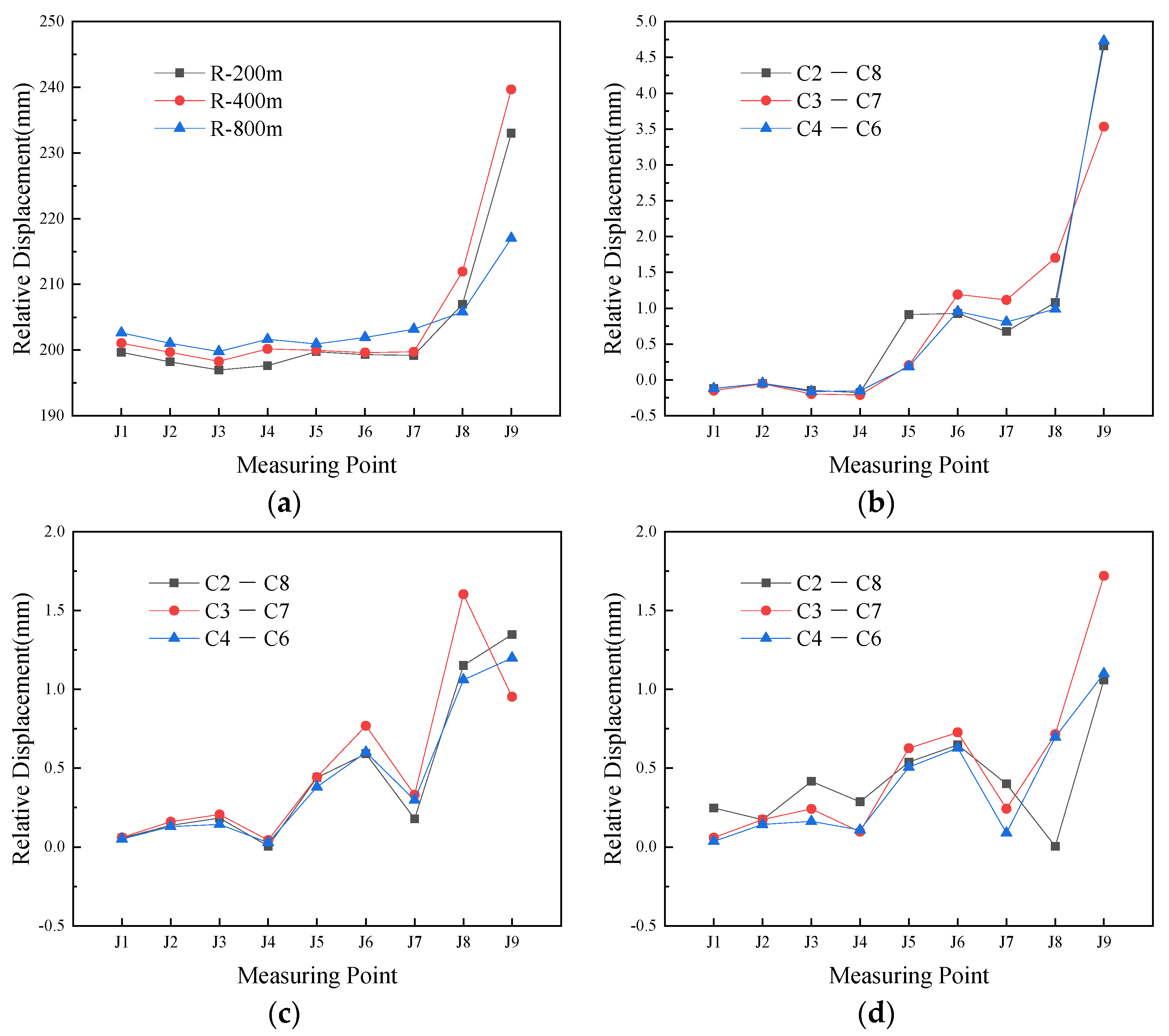

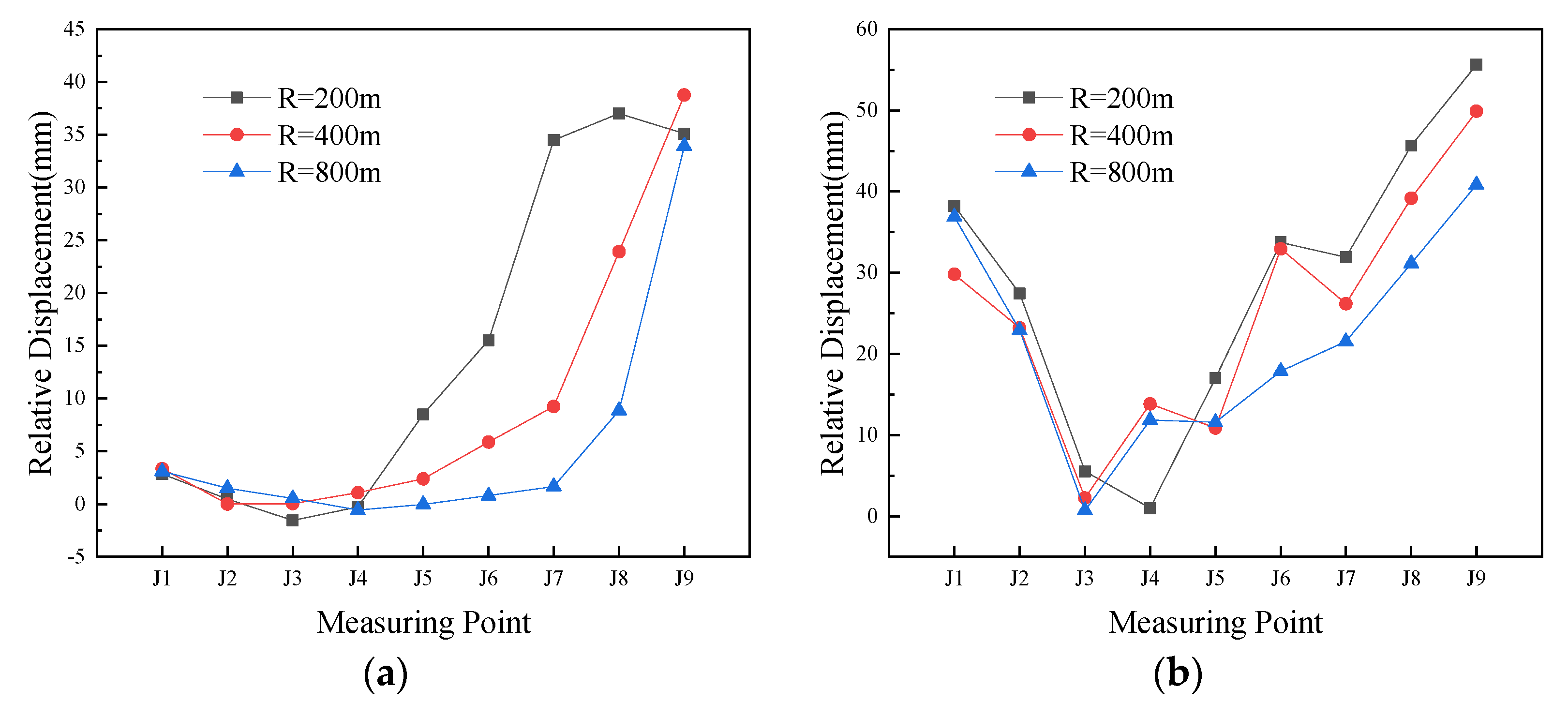
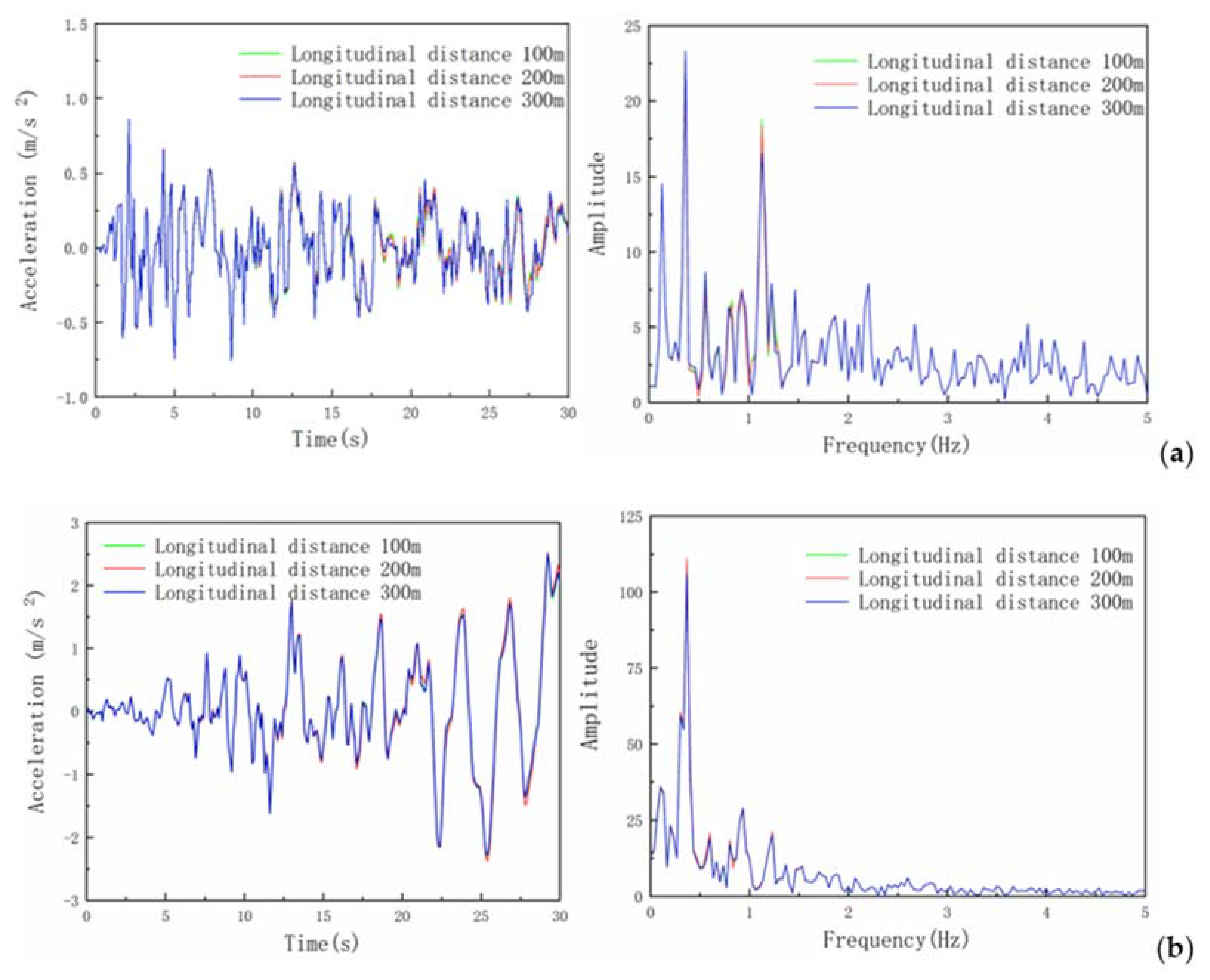
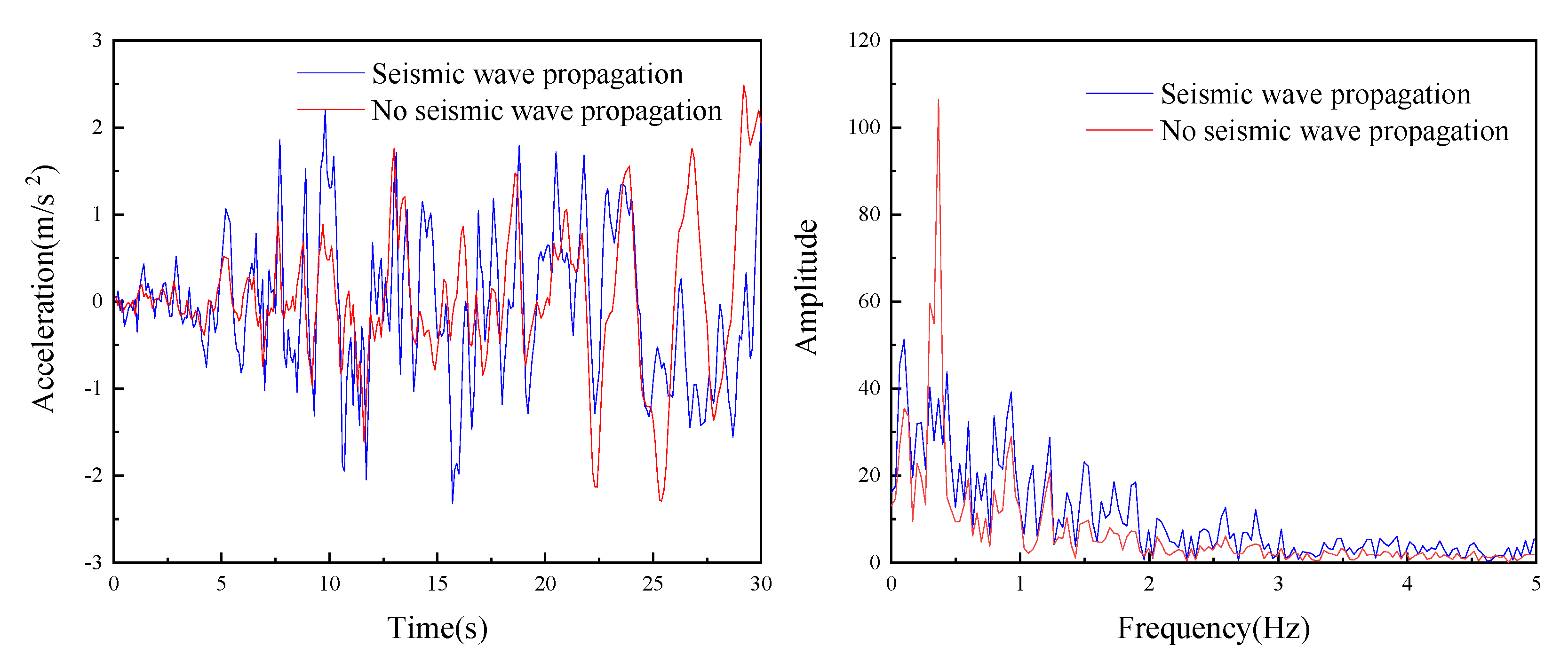
| Material | Unit Weight (kN /m3) | Elastic Modulus (MPa) | Poisson’s Ratio | Cohesion (MPa) | Dilation Angle (°) |
|---|---|---|---|---|---|
| Silty clay | 21 | 16 | 0.22 | 1.8 | 50 |
| Very silty clay | 20 | 6 | 0.28 | 1.2 | 40 |
| Clay | 20 | 3 | 0.32 | 0.8 | 28 |
| Silty clay silty sand | 21 | 13 | 0.30 | 1.9 | 43 |
| Tunnel lining | 25 | 32,500 | 0.3 | — | — |
| Parameters | Lining Thickness | Depth/m | Turning Radius/m | Seismic Wave |
|---|---|---|---|---|
| 1 | 0.3 | 12 | 800 | EI |
| 2 | 0.4 | 12 | 800 | EI |
| 3 | 0.5 | 12 | 800 | EI |
| 4 | 0.4 | 12 | 200 | EI |
| 5 | 0.4 | 12 | 400 | EI |
| 6 | 0.4 | 12 | 800 | EI |
| 7 | 0.4 | 12 | 800 | EI |
| 8 | 0.4 | 12 | 200 | TCU003 |
| 9 | 0.4 | 12 | 400 | TCU003 |
| 10 | 0.4 | 12 | 800 | TCU003 |
| 11 | 0.4 | 8 | 200 | EI (Seismic wave propagation) |
| 12 | 0.4 | 16 | 400 | EI (Seismic wave propagation) |
| 13 | 0.4 | 8 | 800 | EI (Seismic wave propagation) |
| 14 | 0.4 | 16 | 200 | TCU003 (Seismic wave propagation) |
| 15 | 0.4 | 12 | 400 | TCU003 (Seismic wave propagation) |
| 16 | 0.4 | 12 | 800 | TCU003 (Seismic wave propagation) |
Disclaimer/Publisher’s Note: The statements, opinions and data contained in all publications are solely those of the individual author(s) and contributor(s) and not of MDPI and/or the editor(s). MDPI and/or the editor(s) disclaim responsibility for any injury to people or property resulting from any ideas, methods, instructions or products referred to in the content. |
© 2022 by the authors. Licensee MDPI, Basel, Switzerland. This article is an open access article distributed under the terms and conditions of the Creative Commons Attribution (CC BY) license (https://creativecommons.org/licenses/by/4.0/).
Share and Cite
Liu, S.; Yao, L.; Feng, X.; Wang, P. Response Analysis of Curved Tunnel under Near-Field Long-Period Ground Motion Considering Seismic Wave Propagation Effect. Sustainability 2023, 15, 60. https://doi.org/10.3390/su15010060
Liu S, Yao L, Feng X, Wang P. Response Analysis of Curved Tunnel under Near-Field Long-Period Ground Motion Considering Seismic Wave Propagation Effect. Sustainability. 2023; 15(1):60. https://doi.org/10.3390/su15010060
Chicago/Turabian StyleLiu, Shaofeng, Luyan Yao, Xiaojiu Feng, and Peng Wang. 2023. "Response Analysis of Curved Tunnel under Near-Field Long-Period Ground Motion Considering Seismic Wave Propagation Effect" Sustainability 15, no. 1: 60. https://doi.org/10.3390/su15010060
APA StyleLiu, S., Yao, L., Feng, X., & Wang, P. (2023). Response Analysis of Curved Tunnel under Near-Field Long-Period Ground Motion Considering Seismic Wave Propagation Effect. Sustainability, 15(1), 60. https://doi.org/10.3390/su15010060








